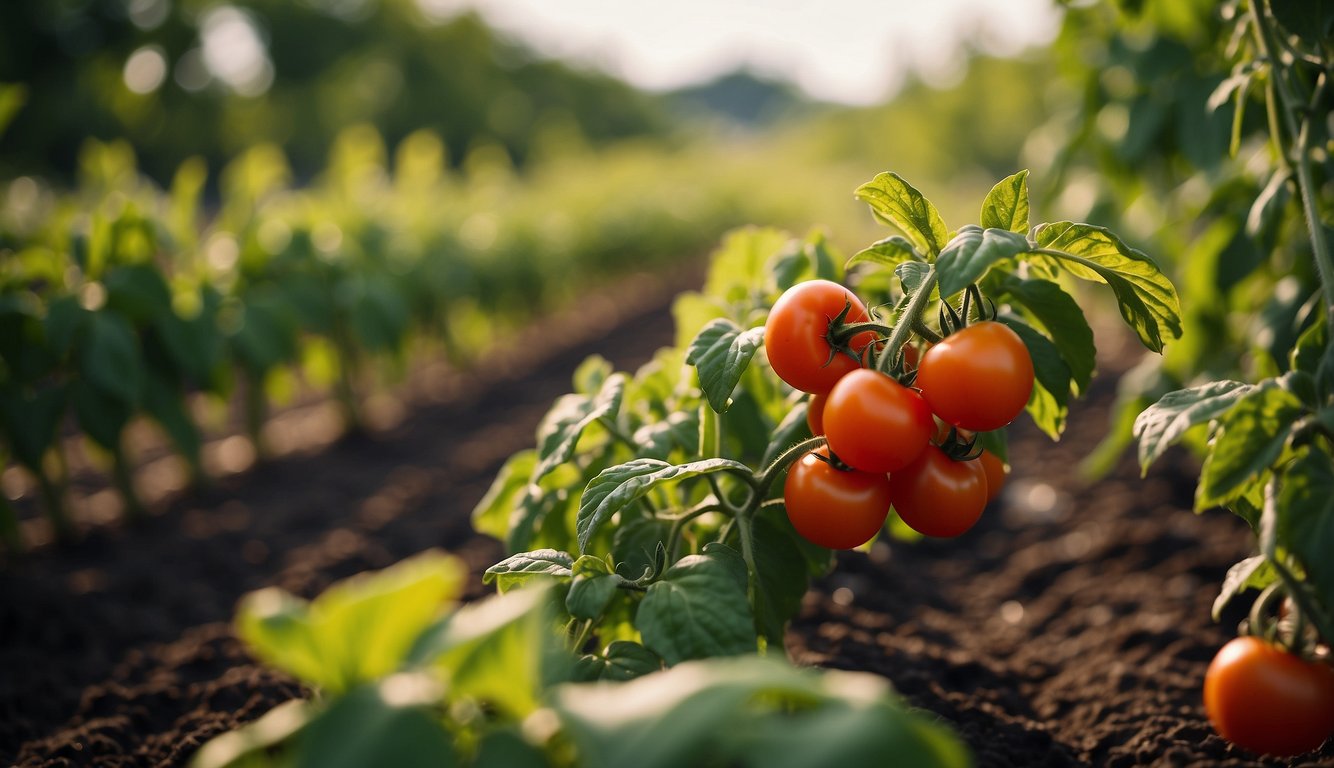TheHerbProf.com is a treasure trove of knowledge for those interested in natural healing and herbal remedies. The website is run by Paul Johnston MD. A naturopathic who has not only received extensive education in the field but also has personal experience in self-healing.
Tomatoes are one of the most popular crops for gardeners, and for good reason. They are versatile, delicious, and packed with nutrients. Growing healthy tomatoes requires the right soil, watering, and pruning techniques, but it also requires the right nutrients. In this article, I will share the best food for tomatoes to help you grow juicy, flavorful fruits.
Healthy tomatoes start with healthy soil. Tomatoes need soil that is rich in organic matter, such as compost or aged manure. However, even the best soil can become depleted over time, especially if you grow tomatoes year after year in the same spot. That’s where fertilizers come in. Fertilizers provide the nutrients that your plants need to thrive, including nitrogen, phosphorus, and potassium. But with so many fertilizers on the market, it can be hard to know which one to choose. In the next section, I will share the best food for tomatoes to help you make an informed decision.
Understanding Tomato Nutrition
As a tomato grower, it’s essential to understand the nutritional requirements of your plants to ensure optimal growth and yield. Tomatoes require a balanced diet of essential nutrients, macronutrients, and micronutrients to thrive.
Essential Nutrients for Tomatoes
Tomatoes require six essential nutrients to grow healthy and strong. These include nitrogen, phosphorus, potassium, calcium, magnesium, and sulfur. Nitrogen is essential for vegetative growth, while phosphorus and potassium are necessary for flower and fruit development. Calcium and magnesium are vital for strong cell walls and overall plant health, while sulfur is necessary for protein synthesis.
The Role of NPK in Tomato Growth
The three macronutrients that are most critical for tomato growth are nitrogen, phosphorus, and potassium, commonly referred to as NPK. Nitrogen is required for vegetative growth, while phosphorus is necessary for flower and fruit development. Potassium plays a vital role in overall plant health, helping to regulate water uptake and improve disease resistance.
To ensure optimal tomato growth, it’s essential to maintain a balanced NPK ratio. During the vegetative stage, a ratio of 9-1.5-7 is recommended, while a ratio of 6-8-12 is ideal during flowering and fruiting.
Micronutrients and Their Benefits
In addition to essential macronutrients, tomatoes require trace elements and minerals called micronutrients. These include zinc, boron, iron, copper, and manganese. Micronutrients are essential for optimal plant growth, helping to regulate enzyme activity, improve disease resistance, and enhance fruit quality.
Zinc is necessary for chlorophyll synthesis and overall plant growth, while boron helps regulate calcium uptake and improve fruit quality. Iron is required for chlorophyll synthesis, while copper is necessary for protein synthesis. Manganese is essential for enzyme activity and overall plant health.
By providing your tomatoes with a balanced diet of essential nutrients, macronutrients, and micronutrients, you can ensure optimal growth and yield. Remember to maintain a balanced NPK ratio and provide your plants with regular feedings of trace elements and minerals to promote healthy, vigorous growth.
Selecting the Best Fertilizer – Best Food for Tomatoes?
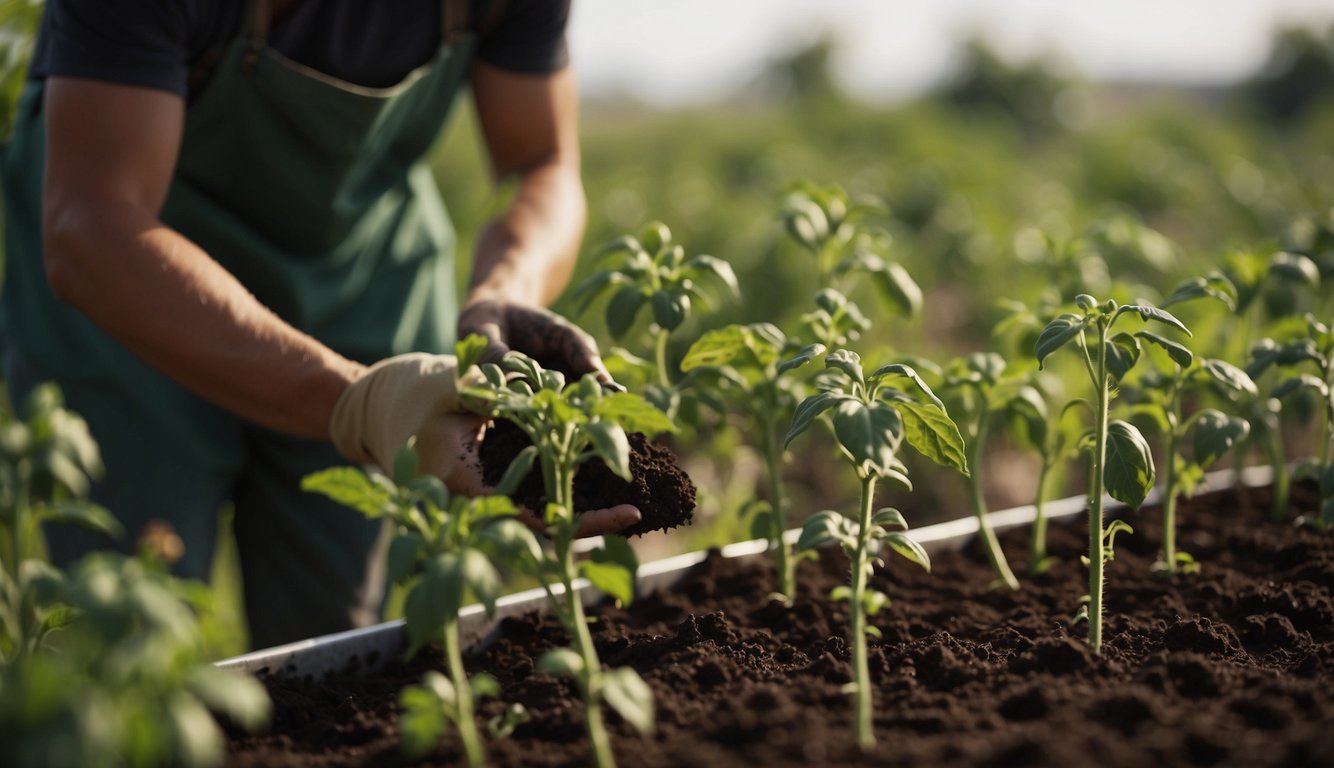
As an avid tomato grower, I know that selecting the right fertilizer is crucial for a bountiful harvest. In this section, I will discuss the different factors to consider when selecting the best fertilizer for your tomato plants.
Organic vs. Synthetic Fertilizers – Best Food for Tomatoes?
The first decision to make is whether to use organic or synthetic fertilizers. Organic fertilizers, such as bone meal and blood meal, are derived from natural sources and are slow-release fertilizers. They improve soil health and promote microbial activity, resulting in healthy and nutrient-rich soil. On the other hand, synthetic fertilizers are fast-acting and provide a quick boost of nutrients to the plants. They are often less expensive than organic fertilizers, but they do not improve soil health in the long run.
Evaluating Fertilizer Options
When evaluating fertilizer options, look for a balanced fertilizer that contains nitrogen, phosphorus, and potassium in equal proportions. Slow-release granular fertilizers are a good option as they release nutrients gradually over time, ensuring that your plants receive a steady supply of nutrients. Fish emulsion is another popular organic fertilizer that is high in nitrogen and provides a quick boost of nutrients to the plants.
Timing and Application Techniques – Best Food for Tomatoes?
Timing and application techniques are also important factors to consider when using fertilizers. Apply fertilizers when the soil is moist, and the plants are actively growing. Avoid applying fertilizers during dry spells or when the plants are stressed. Always follow the instructions on the fertilizer package and do not over-fertilize, as this can lead to nutrient burn and damage to the plants.
Other organic options to consider include wood ash and Epsom salt. Wood ash is high in potassium and can help raise soil pH levels. Epsom salt is high in magnesium and can help promote healthy foliage growth.
Selecting the best fertilizer for your tomato plants is crucial for a successful harvest. Consider the pros and cons of organic and synthetic fertilizers, evaluate different fertilizer options, and follow proper timing and application techniques to ensure healthy and productive plants.
Tomato Plant Care and Maintenance – Best Food for Tomatoes?
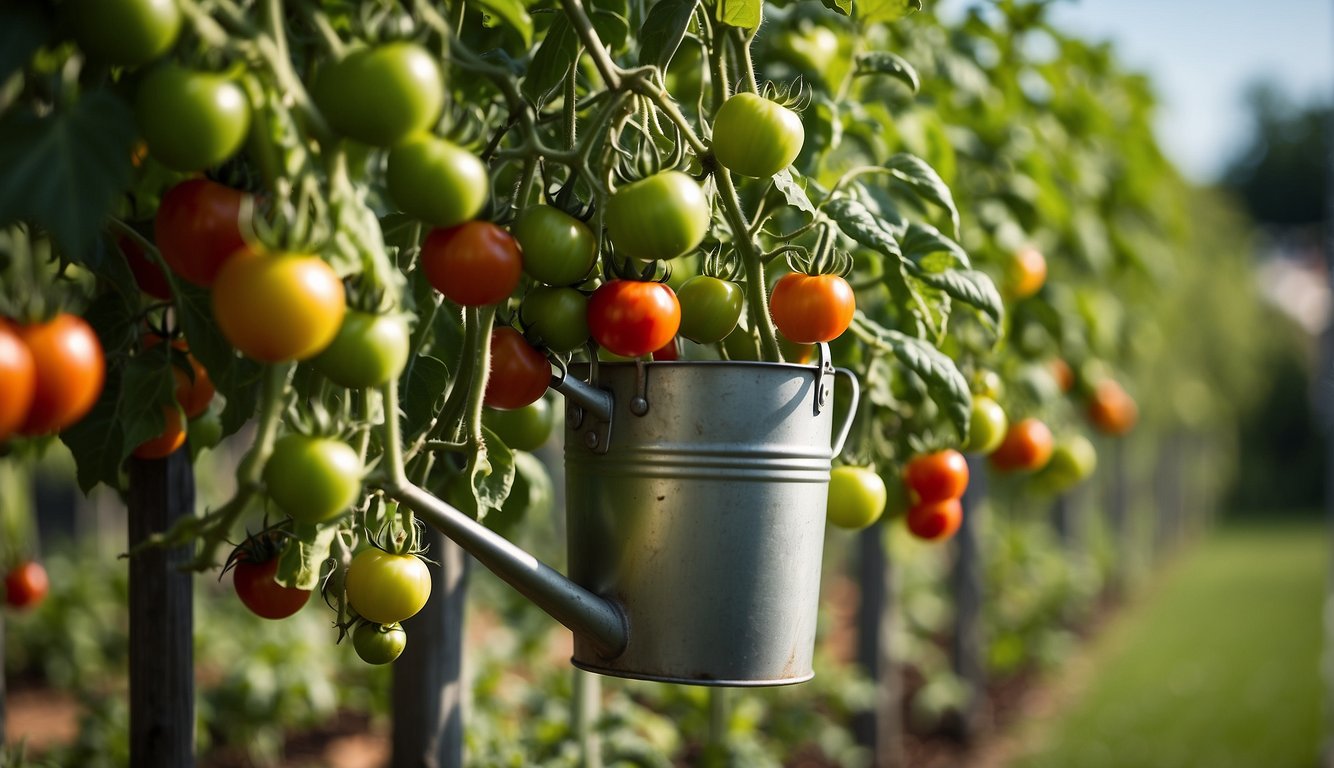
As a tomato plant grows, it requires proper care and maintenance to ensure optimal growth, flowering, and fruit development. In this section, I will cover some essential practices for watering, weeding, pruning, and supporting tomato plants, as well as preventing common tomato diseases.
Watering and Weeding Practices
Tomato plants require consistent watering to thrive. The frequency and amount of water depend on the plant’s growth stage, weather conditions, and soil type. During the growing season, I water my tomato plants deeply once a week, providing about 1-2 inches of water per week. I also mulch around the plants to retain moisture and prevent weed growth.
Weeds can compete with tomato plants for nutrients, water, and light, and can also harbor pests and diseases. To prevent weed growth, I regularly weed around my tomato plants, especially during the early growth stages. Hand weeding is the most effective method, but using a hoe or cultivator can also be helpful.
Pruning and Supporting Tomato Plants – Best Food for Tomatoes?
Pruning and supporting tomato plants can help improve plant growth, fruit development, and disease resistance. I prune my tomato plants by removing the suckers, which are the small shoots that grow between the main stem and the branches. Removing suckers helps the plant focus its energy on fruit production and can also improve air circulation and light penetration.
Supporting tomato plants is also essential to prevent them from falling over due to the weight of the fruit. I use stakes or cages to support my tomato plants, depending on the variety and growth habit. Staking involves tying the main stem to a stake as it grows, while caging involves placing a wire cage around the plant and allowing it to grow inside.
Preventing Common Tomato Diseases
Tomato plants are susceptible to various diseases, including blossom end rot, blight, and leaf spot. To prevent these diseases, I practice good sanitation and hygiene, such as removing infected plant parts and avoiding overhead watering. I also rotate my tomato plants every year to prevent soil-borne diseases from building up in the soil.
In addition, I use disease-resistant tomato varieties and avoid planting them too close together, which can increase the risk of disease spread. Finally, I monitor my tomato plants regularly for signs of disease and take action promptly if I notice any symptoms.
Soil Preparation and Improvement – Best Food for Tomatoes?
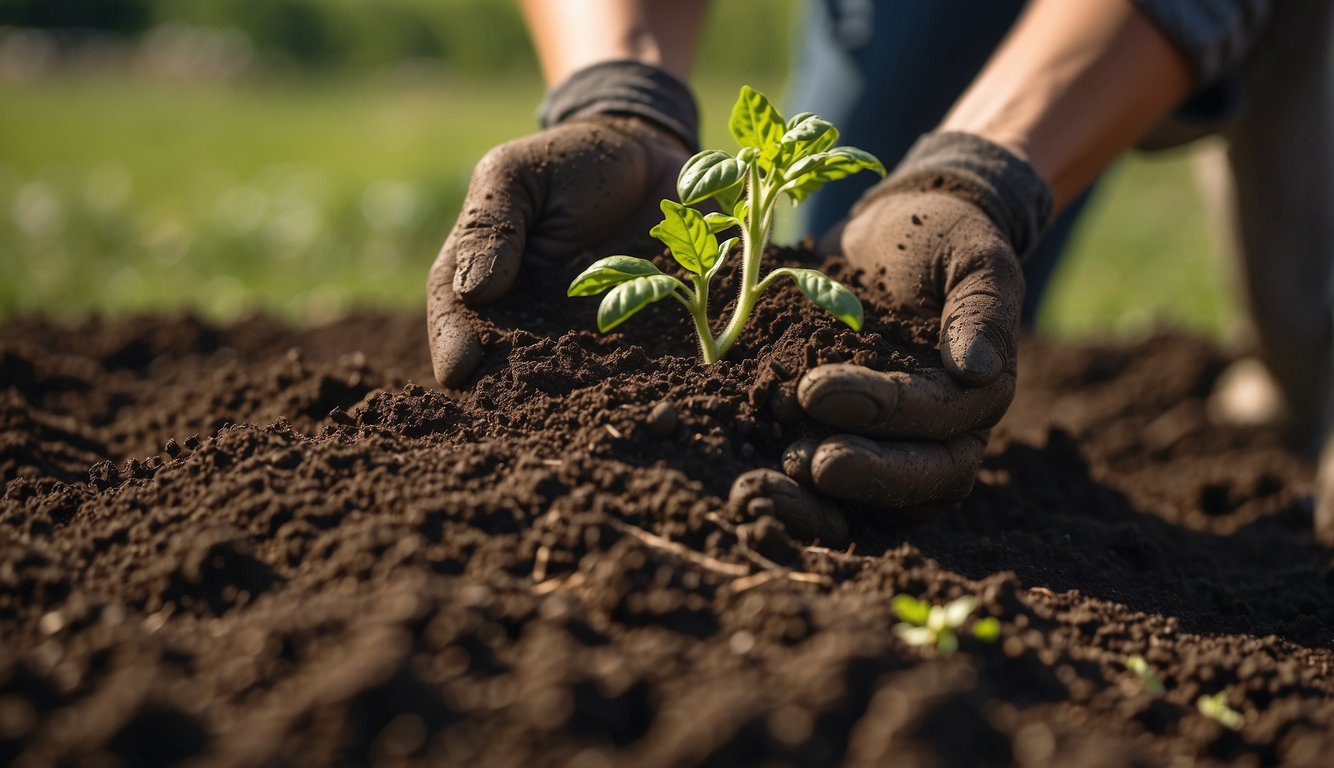
As a tomato gardener, I know that soil preparation is essential for a successful yield. In this section, I will share my knowledge on how to prepare and improve soil for tomato cultivation.
Conducting a Soil Test
Before planting tomatoes, it’s crucial to conduct a soil test to determine the pH level and nutrient content of the soil. A pH level of 6.0 to 7.0 is ideal for growing tomatoes. If the pH is too low, add lime to raise it. If the pH is too high, add sulfur to lower it. A soil test will also reveal any nutrient deficiencies, which can be corrected by adding the appropriate fertilizer.
Amending Soil with Compost – Best Food for Tomatoes?
Compost is an excellent soil amendment that improves soil structure, adds nutrients, and increases water retention. It’s best to add compost to the soil in the fall or early spring before planting. Mix 2-3 inches of compost into the top 6 inches of soil. Compost will also reduce soil compaction, which allows for better root growth and nutrient uptake.
Optimizing Soil for Tomato Yield
To optimize soil for tomato yield, it’s essential to ensure that the soil has good drainage and aeration. Adding perlite or vermiculite to the soil can improve drainage, while adding organic matter such as compost can improve aeration. It’s also important to maintain consistent soil moisture levels, as fluctuations in moisture can lead to blossom end rot and other problems.
Soil preparation is a crucial step in growing healthy and productive tomato plants. Conducting a soil test, amending soil with compost, and optimizing soil for tomato yield are all important factors to consider when preparing soil for tomato cultivation. By following these steps, you can ensure that your tomato plants have the best chance of success.
Tomato Varieties and Selection – Best Food for Tomatoes?
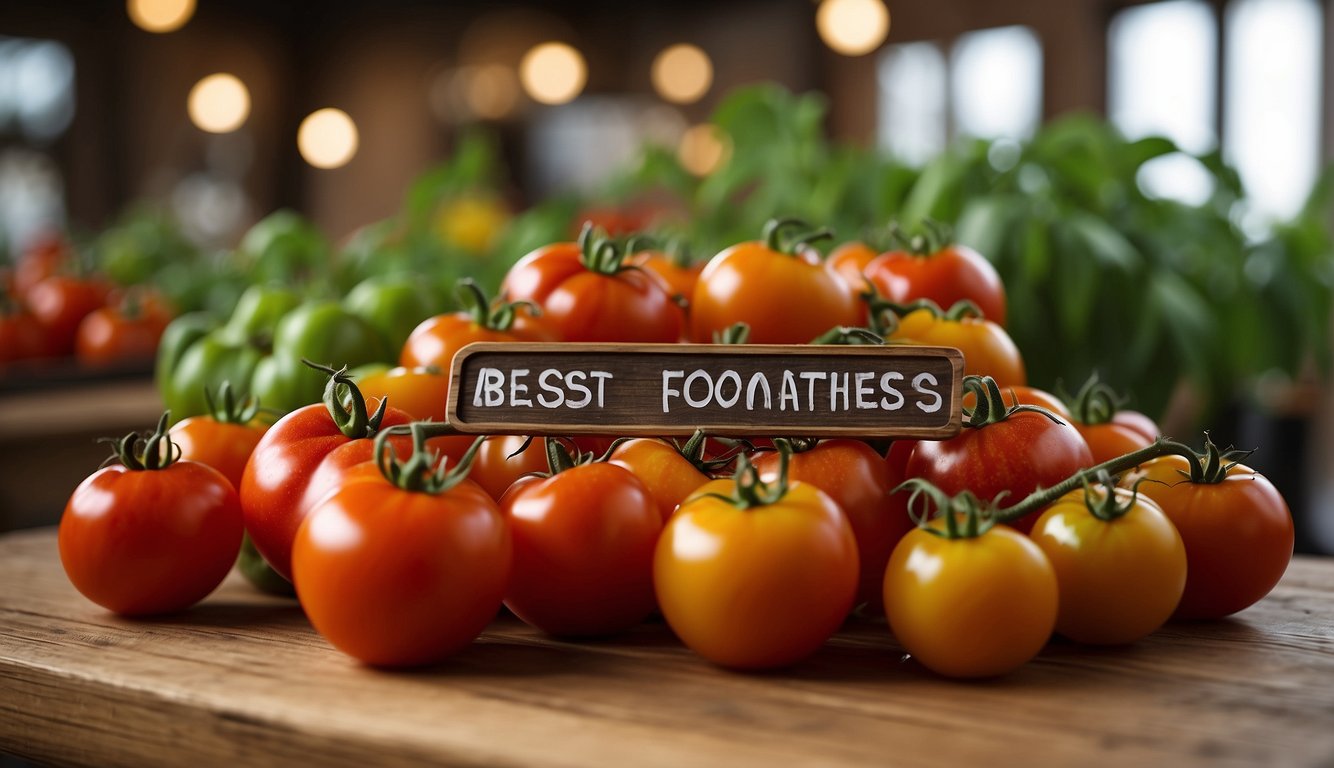
As a tomato enthusiast, I know that selecting the right tomato variety is crucial for a successful harvest. Here are some factors to consider when choosing the best tomato for your garden.
Choosing the Right Tomato for Your Garden – Best Food for Tomatoes?
When selecting a tomato variety, it’s important to consider your climate, soil conditions, and the amount of sunlight your garden receives. Some tomato varieties thrive in hot climates, while others prefer cooler temperatures. For example, cherry tomatoes are perfect for hot summers because they are more heat-tolerant than other varieties. On the other hand, beefsteak tomatoes are better suited for cooler climates.
Another factor to consider is the ripening time of the tomato. Determinate tomatoes ripen all at once, making them perfect for canning or making sauces, while indeterminate tomatoes ripen gradually, giving you a longer harvest period.
Understanding Heirloom vs. Hybrid Tomatoes
When it comes to tomato varieties, you’ll often come across the terms “heirloom” and “hybrid.” Heirloom tomatoes are open-pollinated varieties that have been passed down from generation to generation. They are known for their unique flavors, colors, and shapes. Heirloom tomatoes are often more flavorful than hybrid varieties, but they can be more susceptible to disease and pests.
Hybrid tomatoes, on the other hand, are created by cross-breeding two different tomato varieties. They are often more disease-resistant and have a longer shelf life than heirloom tomatoes. Hybrid tomatoes come in a wide range of colors, sizes, and shapes, and are often bred for specific traits, such as disease-resistance or high yields.
Selecting the right tomato variety is crucial for a successful harvest. Consider your climate, soil conditions, and the ripening time of the tomato when choosing the best variety for your garden. And don’t forget to consider whether you want to grow heirloom or hybrid tomatoes.
Harvesting and Storing Tomatoes – Best Food for Tomatoes?
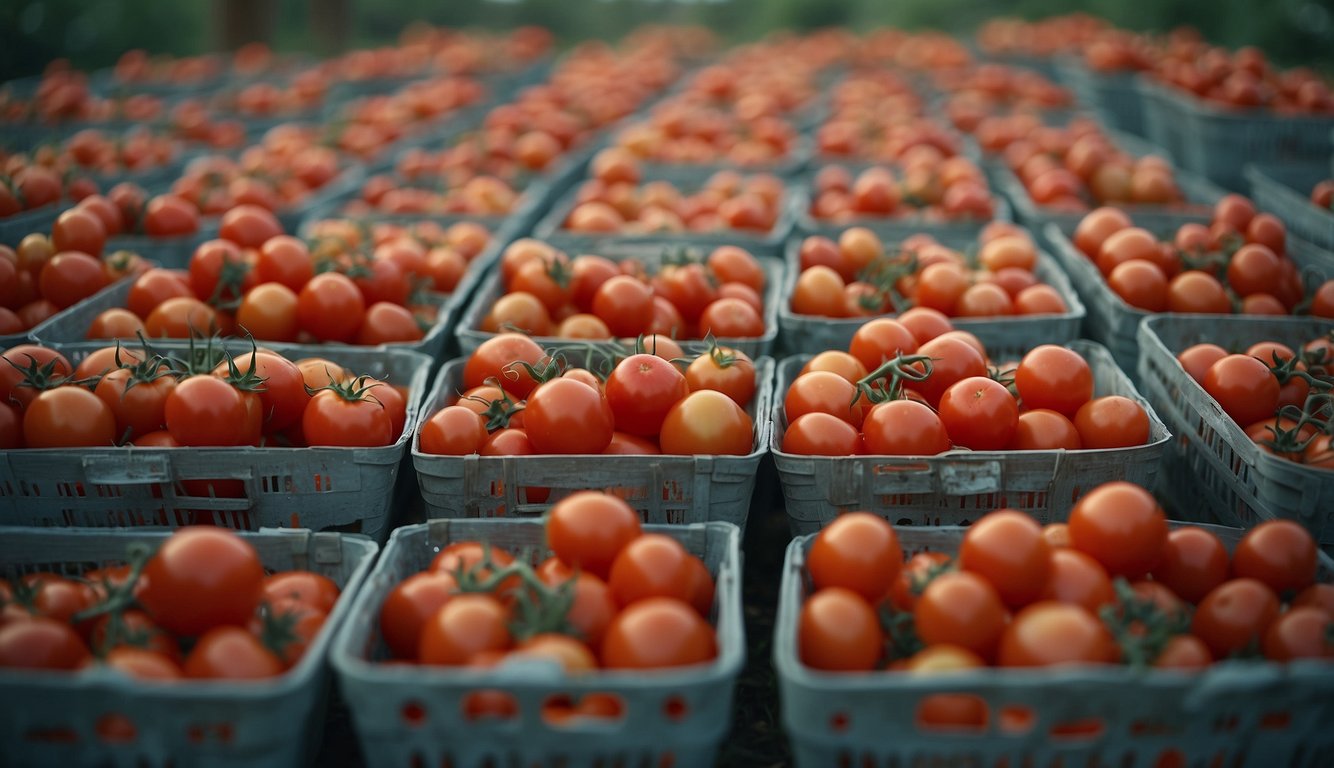
As a tomato lover, I know the importance of harvesting and storing tomatoes properly to maintain their freshness and flavor. In this section, I will share my best practices for picking tomatoes at peak ripeness and storing them for the long term.
Picking Tomatoes at Peak Ripeness
Ripe tomatoes are the key to a delicious tomato-based dish. Picking tomatoes at peak ripeness is crucial to ensure the best flavor and texture. During peak tomato season, which is usually from June to September, it is important to check your tomato plants regularly for ripe tomatoes.
When picking ripe tomatoes, look for tomatoes that are slightly firm, shiny, and uniformly colored. As a tomato ripens, it will turn from a vibrant medium-green to a lighter shade, with faint pink or yellow stripes or flushing. The tomato should also be juicy and fragrant. Gently twist the tomato off the stem, or use pruning shears to cut the stem if necessary.
If you have unripe tomatoes, you can still harvest them and ripen them indoors. Place the unripe tomatoes in a paper bag with an apple or banana, which will release ethylene gas and accelerate the ripening process.
Best Practices for Tomato Storage – Best Food for Tomatoes?
Once you have harvested your ripe tomatoes, it is important to store them properly to maintain their freshness and flavor. Here are some best practices for tomato storage:
- Store ripe tomatoes at room temperature, away from direct sunlight. Do not refrigerate ripe tomatoes, as the cold temperature can damage the texture and flavor.
- If you have a large quantity of ripe tomatoes, you can freeze them for later use. Simply wash and dry the tomatoes, cut them into quarters or halves, and place them in a freezer-safe container or bag.
- If you have excess tomatoes that you cannot use immediately, you can also can them for long-term storage. Follow the proper canning procedures to ensure the safety of your canned tomatoes.
By following these best practices for tomato storage, you can enjoy juicy and flavorful tomatoes all year round.
Tomato-Based Recipes and Preparations – Best Food for Tomatoes?
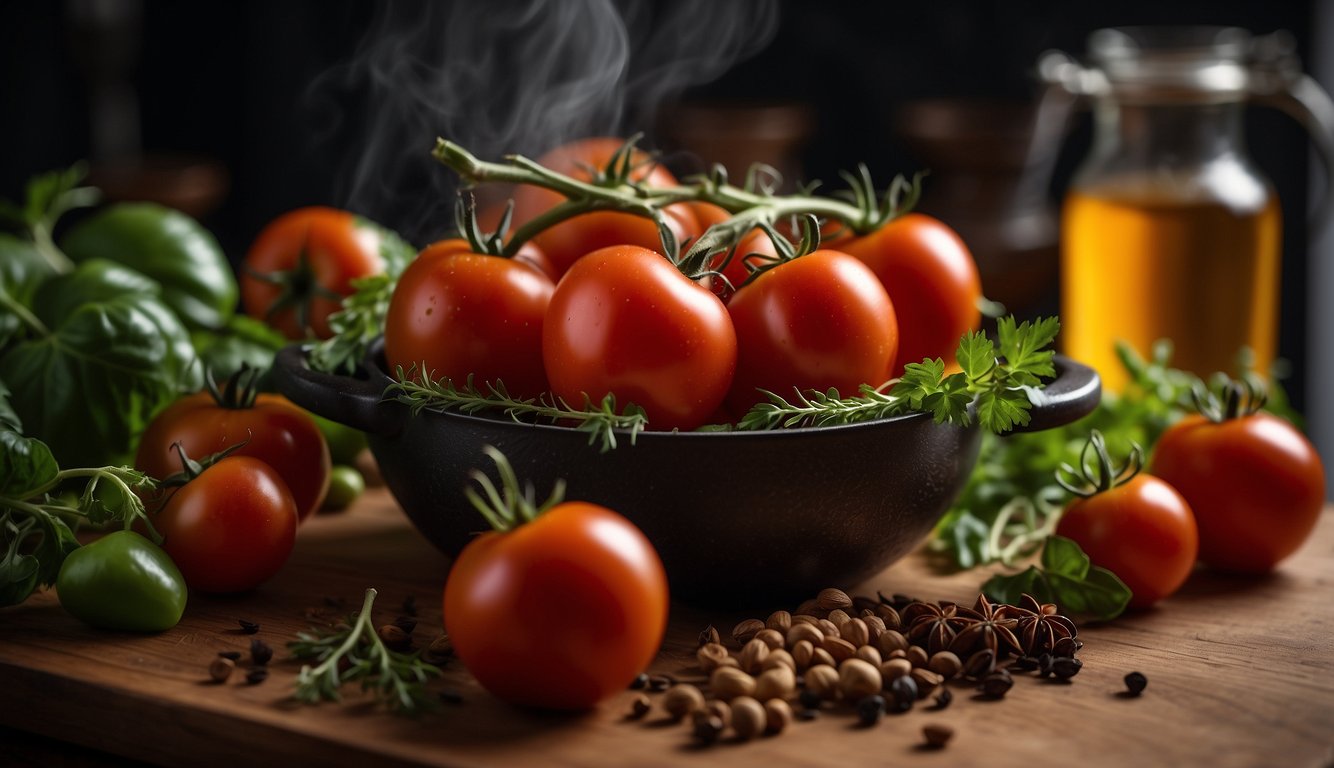
Tomatoes are one of the most versatile and delicious ingredients in the kitchen, and there are countless ways to prepare them. Here are a few of my favorite tomato-based recipes and preparations that are sure to impress.
Simple and Fresh Tomato Salads
One of the best ways to enjoy ripe tomatoes is in a simple and fresh salad. I like to slice them up and toss them with some cucumber, feta cheese, and a simple dressing made with olive oil, balsamic vinegar, and sea salt. For a heartier salad, try adding some grilled corn, chopped veggies, or even some cooked gnocchi.
Homemade Tomato Sauces and Soups – Best Food for Tomatoes?
Fresh tomato sauce is a delicious and healthy alternative to store-bought sauces. I like to make mine with ripe tomatoes, garlic, and herbs like basil and oregano. You can also use fresh tomatoes to make a hearty tomato soup, perfect for those end-of-summer evenings. For a vegan option, try using coconut milk instead of cream.
Creative Tomato Appetizers and Entrees
Tomatoes are a great addition to any appetizer or entree. For a simple yet delicious appetizer, try making bruschetta with chopped tomatoes, garlic, and fresh herbs. For a more substantial meal, try making caprese chicken with fresh mozzarella and ripe tomatoes, or a classic ratatouille with plenty of chopped veggies. And let’s not forget the classic grilled cheese sandwich with tomato soup on the side!
Whether you’re making a fresh tomato salad, a homemade tomato sauce, or a creative tomato appetizer, there are countless ways to enjoy this versatile ingredient. So next time you’re at the farmer’s market or grocery store, be sure to pick up some ripe tomatoes and get cooking!
Best Food for Tomatoes? Let’s Explore with TheHerbProf.com
Today, we’re digging into the delicious world of tomato nutrition. These red beauties need more than just water and sunshine. They need a balanced diet too!
First up, Compost. It’s the black gold of the garden! Rich in nutrients, it’s the perfect food for your tomatoes. And guess what? TheHerbProf.com has a whole section on composting. It’s like having a personal garden guru!
Next, the Bone Meal. Packed with phosphorus, it’s essential for fruit development. And TheHerbProf.com? It’s got all the info you need to use bone meal effectively. It’s a gardener’s dream!
Then there’s the Epsom Salt. It’s not just for baths! It provides magnesium, which tomatoes love. And with TheHerbProf.com, you’ve got a guide to using Epsom salt in your garden. It’s like a spa day for your tomatoes!
In short, feeding tomatoes and TheHerbProf.com are a match made in garden heaven. They offer a blend of practical gardening advice and fascinating plant facts. So, whether you’re a tomato pro or a green newbie, there’s always something new to learn!
Remember, folks, happy tomatoes make tasty tomatoes. Keep exploring TheHerbProf.com for more tomato adventures!
References – Best Food for Tomatoes?
Little Herb Encyclopedia, by Jack Ritchason; N.D., Woodland Publishing Incorporated, 1995
The Ultimate Healing System, Course Manual, Copyright 1985, Don Lepore
Planetary Herbology, Michael Tierra, C.A., N.D., Lotus Press, 1988
Handbook of Medicinal Herbs, by James A. Duke, Pub. CRP Second Edition 2007
The Complete Medicinal Herbal, by Penelope Ody, Published by Dorling Kindersley
Check the Following Articles!
Is Ivy Poisonous to Humans? Exploring the Facts
How Many Types of Tomatoes Are There in the World?
Rooting Hormone Organic: Benefits and Usage Tips
Frequently Asked Questions – Best Food for Tomatoes?
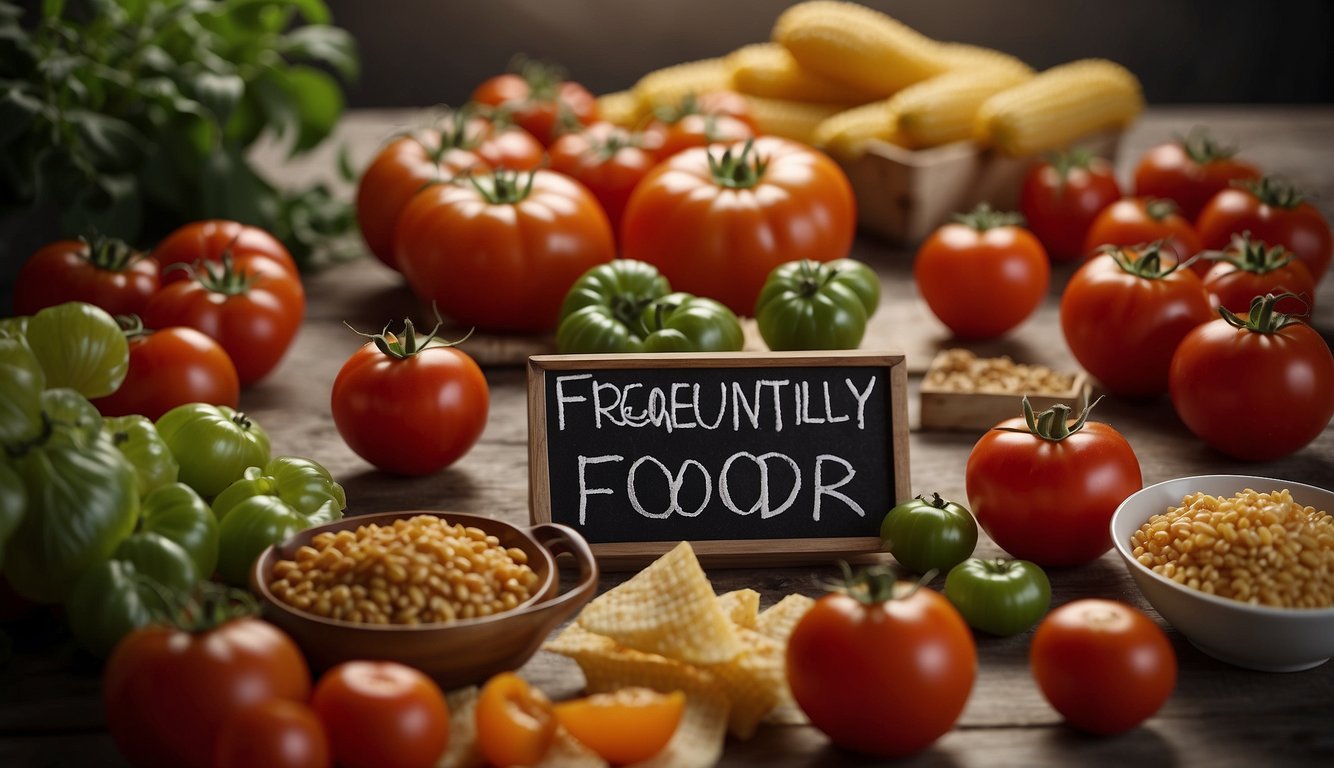
What type of fertilizer yields the best tomato growth?
Tomatoes require a balanced fertilizer that contains essential nutrients such as nitrogen, phosphorus, and potassium. The ideal NPK ratio for tomato plants is 5-10-10 or 10-10-10. However, the type of fertilizer you use depends on the stage of growth and the soil type. Organic fertilizers such as compost, worm castings, and fish emulsion are excellent options for tomato cultivation.
How frequently should tomatoes be fertilized for optimal results?
Tomatoes should be fertilized regularly throughout the growing season. Young tomato plants require frequent feeding every 2-3 weeks, whereas mature plants require feeding every 4-6 weeks. It is important to follow the instructions on the fertilizer package to avoid overfeeding, which can lead to poor fruit quality and growth.
Which organic options are most effective for tomato fertilization?
Organic fertilizers such as compost, worm castings, and fish emulsion are excellent options for tomato cultivation. Compost provides slow-release nutrients and improves soil structure, whereas worm castings contain beneficial microorganisms that enhance soil fertility. Fish emulsion is a fast-acting fertilizer that provides essential nutrients to the tomato plant.
What are the ideal NPK ratios for healthy tomato plants?
The ideal NPK ratio for tomato plants is 5-10-10 or 10-10-10. Nitrogen promotes leafy growth, phosphorus promotes root development and fruit production, and potassium enhances disease resistance and fruit quality. It is important to choose a balanced fertilizer that provides all three essential nutrients in the correct ratio.
Can homemade fertilizers be beneficial for tomato cultivation?
Homemade fertilizers such as compost tea, banana peel tea, and Epsom salt solution can be beneficial for tomato cultivation. Compost tea provides slow-release nutrients and beneficial microorganisms to the soil, whereas banana peel tea is a source of potassium and other essential nutrients. Epsom salt solution contains magnesium, which is essential for healthy tomato growth.
What soil amendments enhance tomato quality and production?
Soil amendments such as lime, bone meal, and gypsum can enhance tomato quality and production. Lime raises the soil pH and provides calcium, which is essential for healthy fruit development. Bone meal is a source of phosphorus and calcium, which promotes root development and fruit production. Gypsum improves soil structure and enhances water retention, which is important for healthy tomato growth.
